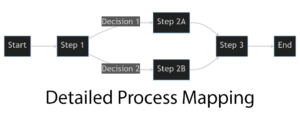In the pursuit of operational excellence, Six Sigma stands as a paragon of success. For aspirants in South Africa’s dynamic market, it is a pivotal stride towards precision, efficiency, and career distinction.
In South Africa, Six Sigma and Lean Six Sigma aren’t just methodologies; they’re vital tools that companies seek out.
In This Guide
Understanding Six Sigma Certification
Six Sigma certification isn’t just an educational achievement; it’s a career milestone that could significantly elevate your professional stature. Certified Six Sigma professionals often stand out in the job market, with many employers viewing this credential as a hallmark of a problem-solver and a leader capable of improving processes and driving quality. This certification often translates into higher earning potential. For instance, a Six Sigma Green Belt in South Africa can earn up to 10-20% more than their uncertified peers, while Black Belts may see even greater increases, affirming the financial upside of this investment.
Career Advancement Through Six Sigma
The value of Six Sigma certification extends beyond monetary gain. It’s a rigorous endorsement of your ability to streamline operations, reduce costs, and enhance quality. This ability opens doors to leadership roles, as many companies in South Africa, particularly in manufacturing, finance, and healthcare, prize these skills for managerial positions. Moreover, the principles of Six Sigma are universally applicable, preparing you for opportunities not just locally but also on an international scale, thus broadening your career prospects.
Is Six Sigma Certification Worth the Investment?
In the quest for professional development, quantifying the return on investment (ROI) of any certification is crucial. Six Sigma’s rigorous approach to process improvement is globally recognized, making its certification a coveted asset in the eyes of employers.
The Cost of Six Sigma Certification in South African Rand
Navigating the Financials of Six Sigma Certification
The journey to Six Sigma certification comes with its financial considerations. In South Africa, the cost can vary widely based on the belt level and training provider. For a basic Yellow Belt certification, you might invest anywhere from R5,000 to R10,000, while a more advanced Black Belt could set you back between R20,000 to R35,000. These figures can encompass training, examination fees, and course materials. It’s also prudent to factor in the potential for additional costs, such as membership fees for professional bodies or costs for retaking exams.
Choosing Your Training Path: In-House vs. Online
When selecting your Six Sigma training, the mode of learning is a significant factor in cost. In-house training programs, which can be more interactive and hands-on, may command a premium for the personalized experience. Conversely, online courses offer flexibility and can be less expensive, with prices ranging significantly based on the provider’s reputation and the comprehensiveness of the materials. For instance, an online Green Belt program might range from R7,000 to R15,000, which could be half the cost of some in-person courses.
Maximizing Value: Cost-Saving Measures
Cost-saving measures can make Six Sigma certification more accessible. Early registration discounts, group enrolment reductions, and seeking out accredited yet affordable online programs are practical strategies. For those employed, exploring employer-sponsored training could be a practical option, as many companies are willing to invest in their employees’ development. Additionally, some training institutions may offer instalment plans or discounts to recent graduates, making it possible for a wider audience to pursue certification without compromising on quality.
Timeline to Six Sigma Certification
The timeline to Six Sigma certification can vary based on several factors, including the level of certification and the individual’s background and experience. For a foundational Yellow Belt, you may need as little as 1 to 3 weeks of part-time study. Moving up, a Green Belt typically needs 2 to 6 months, assuming part-time study alongside professional commitments. For a Black Belt certification, the journey is more intensive, often requiring a full-time commitment of 1 to 3 months of study and project work, or up to 6 months if done alongside employment. Master Black Belt certifications are even more extensive and can take years of dedicated Six Sigma practice and leadership after obtaining a Black Belt.
Balancing Act: Studies and Professional Life
For many, the challenge lies in balancing the certification process with existing professional and personal responsibilities. Effective time management and selecting the right training program that offers flexible scheduling are crucial. Online courses are particularly well-suited for those who need to juggle work and study, as they often allow for self-paced learning. Some South African institutions also offer weekend or evening classes for in-person training, catering to working professionals.
Expedited or Extended: Tailoring Your Certification Path
Not all certification paths are created equal, and the journey can be tailored to your unique circumstances. Intensive courses are available for those wishing to speed up their learning, while extended programs exist for those who prefer a more measured pace. It’s essential to assess your current level of expertise, as prior knowledge and experience can shorten the learning curve. For instance, an individual with a project management background may progress through a Green Belt curriculum faster than someone new to these concepts.
How to Get Six Sigma Certified

Step-by-Step Guide to Certification
Achieving Six Sigma certification follows a structured path. Begin by selecting the proper belt level; start with a Yellow Belt if you’re new, or a Green or Black Belt based on your experience. Next, choose a reputable training provider—ensure they’re accredited, and their curriculum aligns with international standards. Then, enrol in the course, which will typically involve classroom learning, online modules, or a blend of both, culminating in an examination. Upon passing the exam and, in the case of higher belts, completing a project, you’ll earn your certification.
Selecting the Right Training Provider
With numerous institutions offering Six Sigma training, selecting the right one is paramount. Look for providers that offer courses aligned with the IASSC or CSSC Body of Knowledge, as these are widely recognized. Check for testimonials and reviews from former students to gauge the quality of instruction. It’s beneficial to attend info sessions or webinars that many training centres offer, to get a feel for their teaching approach and material quality.
Accreditation and Global Recognition
The global recognition of your Six Sigma certification is as crucial as the knowledge gained. Ensure that your chosen training provider’s certifications are internationally recognized and accredited. This not only ensures the quality of your education but also enhances your mobility in the global job market. Institutions that are aligned with international Six Sigma standards will explicitly say their accreditation status, a critical detail to look for before investing in a program.
Six Sigma Certification FAQs
Is Six Sigma Certification Right for Me?
Choosing to pursue a Six Sigma certification depends on your career goals, interest in process improvement, and dedication to continual learning. It’s ideal for those looking to enhance their analytical skills, increase their marketability, and take on leadership roles in quality management. Assess your goals and whether Six Sigma’s data-driven approach aligns with them.
Can I Pursue Six Sigma Certification Online?
Yes, online Six Sigma certification is a flexible and practical choice. With advancements in e-learning, many reputable institutions offer comprehensive online Six Sigma training that caters to different learning styles and schedules. Ensure the program you choose is accredited and supplies the same level of rigor and recognition as in-person training.
What Are the Prerequisites for Six Sigma Certification?
The prerequisites for Six Sigma certification vary by belt level. A Yellow Belt usually needs no prior experience, making it an excellent entry point for beginners. For Green Belt certification, some familiarity with Six Sigma principles or experience in a process improvement role can be beneficial. Black Belt candidates often need a Green Belt certification or equivalent experience, along with a demonstrated understanding of Six Sigma tools and methodologies.
How Does Six Sigma Certification Help in Career Advancement?
Six Sigma certification can significantly enhance your career prospects by showing your ability in improving business processes and efficiency. Certified individuals are often sought after for their ability to reduce costs, increase customer satisfaction, and improve bottom lines. This can lead to opportunities for higher-level positions, such as quality assurance managers, process engineers, and operations directors.
What Is the Difference Between Six Sigma and Lean Six Sigma Certification?
Six Sigma focuses on reducing process variation and improving quality using statistical tools, while Lean Six Sigma combines these principles with Lean manufacturing techniques to cut waste and streamline processes. Lean Six Sigma certification, therefore, covers a broader set of tools and principles, aimed at enhancing overall efficiency and speed in addition to quality.
Conclusion
In the pursuit of Six Sigma certification, you’re not just gaining a set of skills—you’re making a commitment to a mindset of excellence and continuous improvement. As we’ve explored, the investment in Six Sigma training can translate into significant professional growth, financial benefits, and a deepened understanding of process optimization. The certification journey promises to open doors to new opportunities, equipping you with an internationally recognized qualification that is both respected and sought after in various industries.
Encouraging Lifelong Learning and Growth
Six Sigma isn’t merely a one-time achievement: it’s a stepping stone to lifelong learning and career development. As you consider your path forward, remember that Six Sigma principles are not just about improving processes, but also about fostering a culture of quality that can transform organizations and the individuals within them.
Newsletter
Take the Next Step in Your Six Sigma Journey
Ready to elevate your career with Six Sigma certification? Stay informed and connected with the latest in Six Sigma training and resources. Sign up for our newsletter today and join a community dedicated to excellence. Let’s embark on this journey together, transforming processes and careers, one Sigma at a time.
Subscribe to our newsletter!





